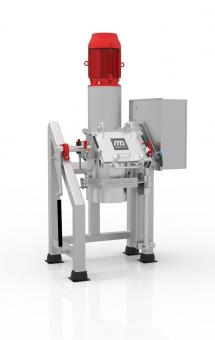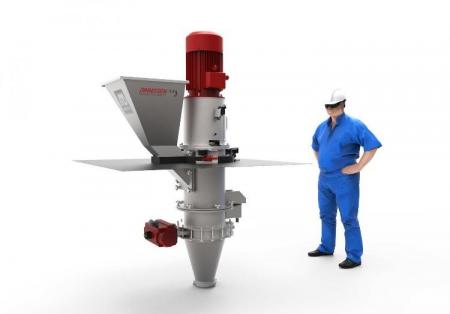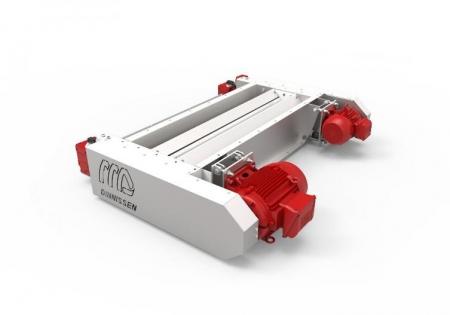This article is a continuation of the article machines for comminuting materials and discusses a number of types of machines that are used to reduce particles, granular products and fiber-rich materials. The devices addressed are:
- The effect of a pulper
- How a shredder works
- The operation of a meat slicer
- The operation of a meat grinder
- The operation of a roller mill
- The effect of a crumbler
The experts at Dinnissen Process Technology are available to answer all your questions:
Get in touch with Juul Jenneskens 077 467 3555
The effect of a pulper
A pulper is a machine that was originally developed for the production of pulp based on compressive forces and shear forces. For this purpose, waste paper and cellulose bales are mixed with water in a bunker. A high-performance agitator ensures that the contents of the reservoir are set in a turbulent movement and that the fibers of the paper and pulp release bales and mix with the water. The separation of the fibers is mainly caused by turbulence and by the internal shear forces in the water-fiber mixture, also called pulp. The impulse forces from the agitator play a minor role in this process.
When the pulp contains an amount of fiber between 4 and 12%, it is referred to as a low-consistency pulper. For a high-consistency pulper, the fiber content is between 12 and 18%. In this case, the pulp can no longer be pumped and a dilution must take place first.
Pulpers are also used in industry to pulp fruit and vegetables. They then function as an industrial blender. Its function is comparable to the household blender. The pulp generated with industrial blenders often serves as a processable product for spraying, mixing and vacuum coating processes. In addition, the pulper is used for the preparation of ready-made "smoothies". Another application is to pulverize alternative raw materials for the feed industry. The pulp then serves as an additive for the conditioning process of algae, insects or other protein substitutes.
Today, the pulper is mainly used as an industrial blender in the food and feed industry. That is why it is hygienically designed and the device can be thoroughly and easily cleaned. The design is aimed at making the main function, the pulverizing of raw materials, run as efficiently as possible. A whirl is created in the pulp via the rotating knives, creating a very fine end product. Since flavor and nutrients are generated, as little heat as possible should be added to the mixture during the pulping process. An additional function with which the industrial blender can be equipped is the possibility to add additives that give the pulp special properties.

A pulper, also known as an industrial blender for vegetables and fruit
How a shredder works
A shredder can refine materials by using sharp blades based on shear forces. Shredders are also referred to as cutting and knife mills. They are suitable for the reduction of soft and tough products, such as leaf herbs, chili peppers, gelatin and cellulose plates. Shredders are also used outside the food and feed industry, for example for recycling plastic, rubber and roofing.
The shredder works on the principle that the knives move at high speed through the product to be processed. The product is in a grinding chamber. Usually there are two counter-rotating rotors to which the blades are attached. The distance between the knives and the housing is adjustable, this determines the product fineness to be achieved. Over time, the blades become less sharp as a result of the cutting. The blades must therefore be able to be changed in a short time. The effectiveness of shredding a particular product depends on product properties, the geometry of the knives and the cutting speed. The cutting speed can be varied because the speed of the rotors is adjustable.
There are also versions of shredders in which the product to be refined is fed in a rotating grinding chamber at high speed along a stationary ring with sharp blades. The knives all cut off a part of the product particles passing by at high speed.
The cutting plates are mounted diverging so that the cut product does not accumulate in front of or behind the knives. The product is fed as a whole along the knives. This results in a very uniform and efficient comminution of the product.

Shredder that refines materials through shear forces
The effectiveness of shredding a particular product depends on product properties, the geometry of the knives and the cutting speed
The operation of a meat slicer
The meat slicer has been specially developed for cutting thin slices of meat. The piece of meat is on a plate that is moved back and forth. A rotating blade is perpendicular to the mobile plate. When moving back and forth, the large piece of meat is passed along the knife and one slice of meat is cut off at each pass. A stop immediately behind and parallel to the rotating blade ensures that the thickness of the slices is the same everywhere.
The operation of a meat grinder
A meat grinder is used for grinding meat and preparing minced meat. Originally, these were manually powered devices that were used both at home in the household and at the butcher. Today, the meat grinder is electrically powered for professional use.
The product to be processed is placed in pieces in a funnel. The material enters a horizontal screw conveyor via the funnel. At the end of this screw conveyor there is a knife that cuts the passing meat into small pieces. Immediately behind the knife is a plate with holes. The meat leaves the meat grinder through these holes as minced meat. The size of the holes determines the fineness of the minced meat.
The operation of a roller mill
A roller mill is used for crushing and grinding various materials, such as grains, oilseeds and biomass based on compressive forces and shear forces. In the roll mill, the product is compressed and comminuted between two counter-rotating rollers. Rollers with different profiles can be used that give the processed products a different structure. The space between the rollers is adjustable, so that the product to be ground can be given any desired size. By placing several roll pairs one above the other, it is possible to obtain an ever greater fineness of the product from top to bottom in several stages.
Characteristic of the roll mill are the high homogeneous grain size distribution, the high capacity and the low energy consumption.

Roller mill that compresses and reduces products
The effect of a crumbler
Crumbles are used for the production of coarse flour grains. Crumbling is an operation in which chunks of animal feed are reduced to coarse flour. Originally, the crumbler was used to reduce feed for broilers. The small crumbs contain all the ingredients that the chicks have to absorb. As a result, it is not possible for the chicks to selectively take ingredients from the feed.
After comminution, the crumbs are sieved to create a desired fraction. The flour that has fallen through the sieve is pressed back into chunks in a press and can be processed again by the crumbler. This operation is not applied for large quantities. After the crumbs have been created, these crumbs must be offered to the chicks. Crumbs that have been stored for too long will turn into flour over time.
The operation of a crumbler is based on two cylindrical rollers, also called crumb rollers, that rotate in the same direction at different speeds. The rollers are provided with grooves on the surface in the longitudinal or transverse direction of the rollers. The grooves cause the chunks between the rollers to fall apart and crumble into smaller parts. The chunks to be crumbled are supplied via a feeding roller. The food roll evenly distributes the chunks over the crumb rolls. If there is no food roll, the chunks to be crumbled are manually distributed over the crumb rolls.
It is possible that a stone or piece of iron will damage the crumb rollers. To prevent this, one of the crumb rollers is spring-mounted. The crumb roll may move slightly when passing this foreign object. The distance between the rollers is adjustable and thus determines the size of the crumbs.

Name: Juul Jenneskens
Advisor
Please feel free to contact me if you have any questions about this subject. My team of colleagues and I are ready to answer!
Get in touch with Juul Jenneskens 077 467 3555 [email protected]
Do you prefer to request a consultation directly?
